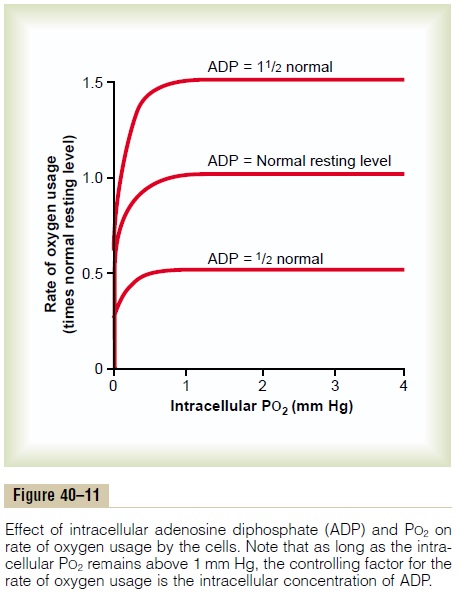Chapter: Medical Physiology: Transport of Oxygen and Carbon Dioxide in Blood and Tissue Fluids
Metabolic Use of Oxygen by the Cells
Metabolic Use of Oxygen by the Cells
Effect of Intracellular PO2 on Rate of Oxygen Usage. Onlya minute level of oxygen pressure is required in the cells for normal intracellular chemical reactions to take place. The reason for this is that the respiratory enzyme systems of the cell, are geared so that when the cellular PO2 is more than 1 mm Hg, oxygen availability is no longer a limiting factor in the rates of the chemical reactions. Instead, the main limiting factor is the concentrationof adenosine diphosphate (ADP) in the cells. Thiseffect is demonstrated in Figure 40–11, which shows the relation between intracellular PO2 and the rate of oxygen usage at different concentrations of ADP. Note that whenever the intracellular PO2 is above 1 mm Hg, the rate of oxygen usage becomes constant for any given concentration of ADP in the cell. Conversely, when the ADP concentration is altered, the rate of oxygen usage changes in proportion to the change in ADP concentration.

When adenosine triphos-phate (ATP) is used in the cells to provide energy, it is converted into ADP. The increasing concentration of ADP increases the metabolic usage of oxygen as it combines with the various cell nutrients, releasing energy that reconverts the ADP back to ATP. Undernormal operating conditions, the rate of oxygen usage by the cells is controlled ultimately by the rate of energy expenditure within the cells—that is, by the rate at which ADP is formed from ATP.
Effect of Diffusion Distance from the Capillary to the Cell on Oxygen Usage. Tissue cells are seldom more than 50micrometers away from a capillary, and oxygen nor-mally can diffuse readily enough from the capillary to the cell to supply all the required amounts of oxygen for metabolism. However, occasionally, cells are located farther from the capillaries, and the rate of oxygen diffusion to these cells can become so low that intracellular PO2 falls below the critical level required to maintain maximal intracellular metabolism. Thus, under these conditions, oxygen usage by the cells is said to be diffusion limited and is no longer deter-mined by the amount of ADP formed in the cells. But this almost never occurs, except in pathological states.
Effect of Blood Flow on Metabolic Use of Oxygen. The totalamount of oxygen available each minute for use in any given tissue is determined by (1) the quantity of oxygen that can be transported to the tissue in each 100 milliliters of blood and (2) the rate of blood flow. If the rate of blood flow falls to zero, the amount of available oxygen also falls to zero. Thus, there are times when the rate of blood flow through a tissue can be so low that tissue PO2 falls below the critical 1 mm Hg required for intracellular metabolism. Under these conditions, the rate of tissue usage of oxygen is blood flow limited. Neither diffusion-limited nor blood flow–limited oxygen states can continue for long, because the cells receive less oxygen than is required to continue the life of the cells.
Related Topics